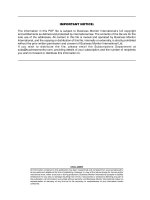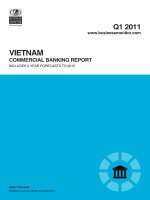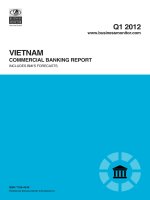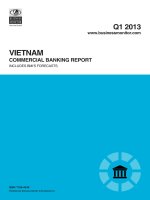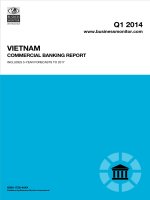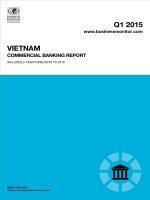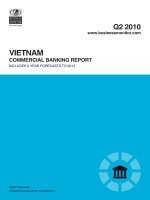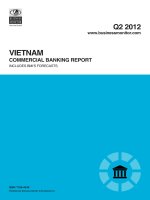Vietnam commercial banking report q2 2010
Bạn đang xem bản rút gọn của tài liệu. Xem và tải ngay bản đầy đủ của tài liệu tại đây (417 KB, 61 trang )
Q2 2010
www.businessmonitor.com
COMMERCIAL BANKING REPORT
ISSN 1758-454X
Published by Business Monitor International Ltd.
VIETNAM
INCLUDES 5-YEAR FORECASTS TO 2014
Business Monitor International
Mermaid House,
2 Puddle Dock,
London, EC4V 3DS,
UK
Tel: +44 (0) 20 7248 0468
Fax: +44 (0) 20 7248 0467
Email:
Web:
© 2010 Business Monitor International.
All rights reserved.
All information contained in this publication is
copyrighted in the name of Business Monitor
International, and as such no part of this publication
may be reproduced, repackaged, redistributed, resold in
whole or in any part, or used in any form or by any
means graphic, electronic or mechanical, including
photocopying, recording, taping, or by information
storage or retrieval, or by any other means, without the
express written consent of the publisher.
DISCLAIMER
All information contained in this publication has been researched and compiled from sources believed to be accurate and reliable at the time of
publishing. However, in view of the natural scope for human and/or mechanical error, either at source or during production, Business Monitor
International accepts no liability whatsoever for any loss or damage resulting from errors, inaccuracies or omissions affecting any part of the
publication. All information is provided without warranty, and Business Monitor International makes no representation of warranty of any kind as
to the accuracy or completeness of any information hereto contained.
VIETNAM COMMERCIAL
BANKING REPORT Q2 2010
INCLUDING 5-YEAR INDUSTRY FORECASTS BY BMI
Part of BMI’s Industry Report & Forecasts Series
Published by: Business Monitor International
Publication date: May 2010
Vietnam Commercial Banking Report Q2 2010
© Business Monitor International Ltd Page 2
Vietnam Commercial Banking Report Q2 2010
© Business Monitor International Ltd Page 3
CONTENTS
Executive Summary 5
Table: Levels (VNDbn) 5
Table: Levels (US$bn) 5
Table: Levels At August 2009 5
Table: Annual Growth Rate Projections 2010-2014 (%) 6
Table: Ranking Out Of 59 Countries Reviewed In 2010 6
Table: Projected Levels (VNDbn) 6
Table: Projected Levels (US$bn) 6
SWOT Analysis 7
Vietnam Commercial Banking SWOT 7
Vietnam Political SWOT 8
Vietnam Economic SWOT 9
Vietnam Business Environment SWOT 10
Business Environment Outlook 11
Commercial Banking Business Environment Rating 11
Table: Commercial Banking Business Environment Rating 11
Commercial Banking Business Environment Rating Methodology 12
Table: Asia Commercial Banking Business Environment Ratings 13
Global Commercial Banking Outlook 14
Asia Banking Sector Outlook 16
Five Themes For The Regional Banking Sector 16
Comparison Of Loan/Deposit & Loan/Asset & Loan/GDP Ratios 20
Anticipated Developments In 2010 21
Comparison Of Total Assets & Client Loans & Client Deposits (US$bn) 22
Comparison Of US$ Per Capita Deposits (Late 2009) 23
Interbank Rates & Bond Yields 24
Vietnam Banking Sector Outlook 25
Economic Outlook 28
Table: Vietnam Economic Activity, 2007-2014 30
Competitive Landscape 31
Protagonists 31
Table: Protagonists In Vietnam’s Commercial Banking Sector 31
Definition Of The Commercial Banking Universe 31
List Of Banks 32
Table: Financial Institutions In Vietnam (February 2010) 32
Company Profiles 35
Vietcombank 35
Table: Key Statistics For Vietcombank, 2004-2007 (VNDmn) 36
BIDV 37
VietinBank 39
Table: Key Statistics For VietinBank, 2005-2007 (VNDmn) 40
Vietnam Commercial Banking Report Q2 2010
© Business Monitor International Ltd Page 4
Agribank 41
Balance Sheet (VNDmn) 42
Balance Sheet (US$mn) 42
Key Ratios (%) 42
MHB Bank 43
Table: Key Statistics For MHB Bank, 2006-2007 (VNDmn) 44
Habubank 45
Balance Sheet (VNDmn, unless stated) 46
Balance Sheet (US$mn, unless stated) 46
Key Ratios (%) 46
Eximbank 47
Balance Sheet (VNDmn, unless stated) 48
Balance Sheet (US$mn, unless stated) 48
Key Ratios (%) 48
Sacombank 49
Stock Market Indicators 50
Balance Sheet (VNDmn, unless stated) 50
Balance Sheet (US$mn, unless stated) 51
Key Ratios (%) 51
Saigonbank 52
Balance Sheet (VNDmn) 53
Balance Sheet (US$mn) 53
Key Ratios (%) 53
SeABank 54
Balance Sheet (VNDmn, unless stated) 55
Balance Sheet (US$mn, unless stated) 55
Key Ratios (%) 55
BMI Banking Sector Methodology 56
Commercial Bank Business Environment Rating 57
Table: Commercial Banking Business Environment Indicators And Rationale 58
Table: Weighting Of Indicators 59
Vietnam Commercial Banking Report Q2 2010
© Business Monitor International Ltd Page 5
Executive Summary
Table: Levels (VNDbn)
Date
Total
assets
Client
loans
Bond
portfolio Other
Liabilities &
capital Capital
Client
deposits Other
August
2008 1,659,548.7 1,259,980.0 149,816.7 249,752.0 1,659,548.7 217,173.0 1,205,967.7 236,408.0
August
2009 2,065,761.6 1,706,340.0 173,358.3 186,063.3 2,065,761.6 286,547.0 1,594,992.6 184,222.0
Change,
% 24 35 16 -26 24 32 32 -22
Source: BMI, central banks, regulators
Table: Levels (US$bn)
Date
Total
assets
Client
loans
Bond
portfolio Other
Liabilities &
capital Capital
Client
deposits Other
August
2008
100.4 76.2 9.1 15.1 100.4 13.1 73.0 14.3
August
2009
116.0 95.8 9.7 10.4 116.0 16.1 89.6 10.3
Change, % 15% 26% 7% -31% 15% 22% 23% -28%
Source: BMI, central banks, regulators
Table: Levels At August 2009
Loan/deposit ratio Loan/asset ratio Loan/GDP ratio
GDP per capita,
US$
Deposits per
capita, US$
106.98% 82.60% 107.32% 1,013 1,022
Rising Falling Rising
Source: BMI, central banks, regulators
Vietnam Commercial Banking Report Q2 2010
© Business Monitor International Ltd Page 6
Table: Annual Growth Rate Projections 2010-2014 (%)
Assets Loans Deposits
Annual Growth Rate 20 20 14
CAGR 21 24 13
Ranking 1 1 12
Source: BMI, central banks, regulators
Table: Ranking Out Of 59 Countries Reviewed In 2010
Loan/deposit ratio Loan/asset ratio Loan/GDP ratio
10 1 12
Local currency asset growth Local currency loan growth Local currency deposit growth
1 1 10
Source: BMI, central banks, regulators
Table: Projected Levels (VNDbn)
2007 2008 2009e 2010f 2011f 2012f 2013f 2014f
Total assets 1410221.40 1747335.40 2271536.02 2612266.42 3134719.71 3761663.65 4513996.38 5416795.65
Client loans 1067730.00 1339260.00 1848178.80 2254778.14 2705733.76 3246880.52 3896256.62 4675507.94
Client deposits 1100392.90 1341142.80 1528902.79 1697082.10 1917702.77 2186181.16 2492246.52 2841161.04
e/f = BMI estimate/forecast. Source: BMI, central banks, regulators
Table: Projected Levels (US$bn)
2007 2008 2009 2010 2011 2012 2013 2014
Total assets 88.04 99.96 122.99 133.96 156.74 188.08 231.49 285.09
Client loans 66.66 76.62 100.07 115.63 135.29 162.34 199.81 246.08
Client deposits 68.70 76.72 82.78 87.03 95.89 109.31 127.81 149.53
e/f = estimate/forecast. Source: BMI, central banks, regulators
Vietnam Commercial Banking Report Q2 2010
© Business Monitor International Ltd Page 7
SWOT Analysis
Vietnam Commercial Banking SWOT
Strengths
! Rapid growth in the industry.
! Untapped potential in the market.
! High savings rate of Vietnamese consumers.
! The Vietnamese commercial banking sector is open to foreign banks.
! No overwhelming local majority in the market.
Weaknesses
! It is still an underdeveloped and opaque industry.
! Still recovering from the bursting of the asset price bubble in early 2008.
Opportunities
! The Vietnamese population is under-banked.
! Income levels are likely to rise strongly over the medium term.
Threats
! The impact of global economic downturn and financial crisis.
Vietnam Commercial Banking Report Q2 2010
© Business Monitor International Ltd Page 8
Vietnam Political SWOT
Strengths
! The Communist Party government appears committed to market-oriented
reforms, although specific economic policies will undoubtedly be discussed at
the 2011 National Congress. The one-party system is generally conducive to
short-term political stability.
! Relations with the US are generally improving, and Washington sees Hanoi as a
potential geopolitical ally in South East Asia.
Weaknesses
! Corruption among government officials poses a major threat to the legitimacy of
the ruling Communist Party.
! There is increasing (albeit still limited) public dissatisfaction with the leadership’s
tight control over political dissent.
Opportunities
! The government recognises the threat that corruption poses to its legitimacy,
and has acted to clamp down on graft among party officials.
! Vietnam has allowed legislators to become more vocal in criticising government
policies. This is opening up opportunities for more checks and balances within
the one-party system.
Threats
! The slowdown in growth in 2009 and 2010 is likely to weigh on public
acceptance of the one-party system, and street demonstrations to protest
economic conditions could develop into a full-on challenge of undemocractic
rule.
! Although strong domestic control will ensure little change to Vietnam’s political
scene in the next few years, over the longer term, the one-party-state will
probably be unsustainable.
! Relations with China have deteriorated over the past year due to Beijing’s more
assertive stance over disputed islands in the South China Sea and domestic
criticism of a large Chinese investment into a bauxite mining project in the
central highlands, which could potentially cause large environmental damage.
Vietnam Commercial Banking Report Q2 2010
© Business Monitor International Ltd Page 9
Vietnam Economic SWOT
Strengths
! Vietnam has been one of the fastest-growing economies in Asia in recent years,
with GDP growth averaging 7.6% annually between 2000 and 2007.
! The economic boom has lifted many Vietnamese out of poverty, with the official
poverty rate in the country falling from 58% in 1993 to 20% in 2004.
Weaknesses
! Vietnam still suffers from substantial trade, current account and fiscal deficits,
leaving the economy vulnerable as the global economy continues to suffer in
2010. The fiscal picture is clouded by considerable ‘off-the-books’ spending.
! The heavily-managed and weak dong currency reduces incentives to improve
quality of exports, and also serves to keep import costs high, thus contributing
to inflationary pressures.
Opportunities
! WTO membership has given Vietnam access to both foreign markets and
capital, while making Vietnamese enterprises stronger through increased
competition.
! The government will in spite of the current macroeconomic woes, continue to
move forward with market reforms, including privatisation of state-owned
enterprises, and liberalising the banking sector.
! Urbanisation will continue to be a long-term growth driver. The UN forecasts the
urban population to rise from 29% of the population to more than 50% by the
early 2040s.
Threats
! Inflation and deficit concerns have caused some investors to re-assess their
hitherto upbeat view of Vietnam. If the government focuses too much on
stimulating growth and fails to root out inflationary pressure, it risks prolonging
macroeconomic instability, which could lead to a potential crisis.
! Prolonged macroeconomic instability could prompt the authorities to put reforms
on hold, as they struggle to stabilise the economy.
Vietnam Commercial Banking Report Q2 2010
© Business Monitor International Ltd Page 10
Vietnam Business Environment SWOT
Strengths
! Vietnam has a large, skilled and low-cost workforce, that has made the country
attractive to foreign investors.
! Vietnam’s location - its proximity to China and South East Asia, and its good
sea links - makes it a good base for foreign companies to export to the rest of
Asia, and beyond.
Weaknesses
! Vietnam’s infrastructure is still weak. Roads, railways and ports are inadequate
to cope with the country’s economic growth and links with the outside world.
! Vietnam remains one of the world’s most corrupt countries. Its score in
Transparency International’s 2008 Corruption Perceptions Index was 2.7,
placing it in 20th place in the Asia-Pacific region.
Opportunities
! Vietnam is increasingly attracting investment from key Asian economies, such
as Japan, South Korea and Taiwan. This offers the possibility of the transfer of
high-tech skills and knowhow.
! Vietnam is pressing ahead with the privatisation of state-owned enterprises and
the liberalisation of the banking sector. This should offer foreign investors new
entry points.
Threats
! Ongoing trade disputes with the US, and the general threat of American
protectionism, which will remain a concern.
! Labour unrest remains a lingering threat. A failure by the authorities to boost
skills levels could leave Vietnam a second-rate economy for an indefinite period.
Vietnam Commercial Banking Report Q2 2010
© Business Monitor International Ltd Page 11
Business Environment Outlook
Commercial Banking Business Environment Rating
Table: Commercial Banking Business Environment Rating
Limits of Potential
Returns
Data Score, out of 10 Ratings score, out of 100
Total assets, end 2008 US$100mn 5 Market Structure 60
Growth in total assets,
2008-2013
US$131.5mn 6
Growth in client loans,
2008-2013 US$123.2mn 7
Per capita GDP, 2008 US$974.7 1 Country Structure 48
Tax 5.9 6
GDP volatility 1.4 9
Financial infrastructure 3.0 3
Risks to Realisation of
Returns
Regulatory framework
and development 4.5 5 Market Risk 40
Regulatory framework
and competitive
landscape
5.0 5
Moody’s rating for local
currency deposits 2.0 2
Long-term financial risk 6.0 6 Country Risk 50
Long-term external risk 3.3 3
Long-term policy
continuity 7.0 7
Legal framework 3.9 4
Bureaucracy 4.9 5
Commercial Banking
Business Environment
Rating
52
Source: BMI
Vietnam Commercial Banking Report Q2 2010
© Business Monitor International Ltd Page 12
Commercial Banking Business Environment Rating Methodology
Since Q108, we have described numerically the banking business environment for each of the countries
surveyed by BMI. We do this through our Commercial Banking Business Environment Rating (CBBER),
a measure that ensures we capture the latest quantitative information available. It also ensures consistency
across all countries and between the inputs to the CBBER and the Insurance Business Environment
Rating, which is likewise now a feature of our insurance reports. Like the Business Environment Ratings
calculated by BMI for all the other industries on which it reports, the CBBER takes into account the
limits of potential returns and the risks to the realisation of those returns. It is weighted 70% to the former
and 30% to the latter.
The evaluation of the Limits of Potential Returns includes market elements that are specific to the
banking industry of the country in question and elements that relate to that country in general. Within the
70% of the CBBER that takes into account the Limits of Potential Returns, the market elements have a
60% weighting and the country elements have a 40% weighting. The evaluation of the Risks to the
Realisation of Returns also includes banking elements and country elements (specifically, BMI’s
assessment of long-term country risk). However, within the 30% of the CBBER that take into account the
risks, these elements are weighted 40% and 60%, respectively.
Further details on how we calculate the CBBER are provided at the end of this report. In general, though,
three aspects need to be borne in mind in interpreting the CBBERs. The first is that the market elements
of the Limits of Potential Returns are by far the most heavily weighted of the four elements. They account
for 60% of 70% (or 42%) of the overall CBBER. Second, if the market elements are significantly higher
than the country elements of the Limits of Potential Returns, it usually implies that the banking sector is
(very) large and/or developed relative to the general wealth, stability and financial infrastructure in the
country. Conversely, if the market elements are significantly lower than the country elements, it usually
means that the banking sector is small and/or underdeveloped relative to the general wealth, stability and
financial infrastructure in the country. Third, within the Risks to the Realisation of Returns category, the
market elements (ie: how regulations affect the development of the sector, how regulations affect
competition within it, and Moody’s Investor Services’ ratings for local currency deposits) can be
markedly different from BMI’s long-term risk rating.
Vietnam Commercial Banking Report Q2 2010
© Business Monitor International Ltd Page 13
Table: Asia Commercial Banking Business Environment Ratings
Limits of Potential
Returns
Risks to Potential
Returns Overall
Market
Structure
Country
Structure
Market
Risks
Country
Risks Rating Ranking
Bangladesh 43.3 57.5 30.0 46.0 46.2 49
China 90.0 50.0 56.7 68.0 70.8 16
Hong Kong 66.7 87.5 70.0 82.0 75.7 9
India 80.0 40.0 53.3 60.0 62.0 30
Indonesia 66.7 60.0 76.7 48.0 62.6 29
Japan 30.0 72.5 63.3 72.0 53.5 41
Malaysia 66.7 77.5 76.7 70.0 71.5 14
Pakistan 30.0 47.5 56.7 42.0 40.3 53
Philippines 46.7 47.5 56.7 52.0 49.1 48
Singapore 66.7 85.0 96.7 84.0 78.5 4
Sri Lanka 13.3 45.0 36.7 52.0 32.0 59
South Korea 80.0 62.5 76.7 74.0 73.6 11
Taiwan 66.7 77.5 83.3 64.0 71.2 15
Thailand 63.3 67.5 80.0 64.0 66.6 21
Vietnam 60.0 47.5 40.0 50.0 52.3 42
US 83.3 85.0 100.0 80.0 85.2 1
Scores out of 100, with 100 the highest. Source: BMI
Vietnam Commercial Banking Report Q2 2010
© Business Monitor International Ltd Page 14
Global Commercial Banking Outlook
Regulatory Reform To The Fore
Calls for a new regulatory system for the global banking sector have gained momentum on both sides of
the Atlantic, and in a continuation of a theme we started highlighting in 2009, we believe that in 2011
there could be some major changes put into place.
With elections ahead this year in the US and the UK, which together formed the epicentre of the global
financial crisis, increasing attention is being cast upon banking regulation. Although proposals are still in
their early stages, it is increasingly clear that the industry faces its biggest regulatory tightening since the
Great Depression of the 1930s.
US President Barack Obama proposed a scheme in January 2010 that includes a ban on commercial bank
proprietary trading, as well as ownership, investment in, or sponsorship of hedge funds and private equity.
Our interpretation of the White House’s proposals suggest the potential for a revival of the Glass-Steagall
Banking Act that separates commercial and investment banking operations, which was enacted during the
Great Depression and repealed in 1999. More than a mere intensification of size restrictions, the main
issue raised by Obama’s plan is banning banks from pursuing a number of high risk activities such as
prop trading, forcing a choice between owning a deposit taking institution and engaging in higher-risk
activities. Thus the banks most affected by the Obama plan, at least in its preliminary stages, would be the
largest integrated banks such as JPMorgan Chase and Bank of America. Deposit-taking institutions
would be allowed to facilitate customer orders as brokers have always done and continue to underwrite
new issues of stocks and bonds but very little else. Those banks that wished to stick to high risk activities
would be free to do so, but would have to sell their retail banking assets and, as a result, lose access to
emergency federal funding.
Across the Atlantic, Bank of England governor Mervyn King has also argued for a comprehensive
regulatory regime change. His ‘three-legged stool’ approach, outlined in January 2010, includes higher
capital requirements, predetermined plans for bank failures (‘living wills’) and a major overhaul of the
banking industry’s structure in an attempt to reduce systemic risk. The key, King said, is a structure that is
comprehensive enough to avoid a major systemic crisis. King said: ’The right thing is not to pretend in
advance you can stop [a crisis] from happening but to design a system that is resilient enough, so that
when it still happens one part of the sector doesn’t bring down the other’. At its heart is the idea that
banks should not be ‘too big to fail’, and like Obama’s proposal the endgame would probably be a
divestiture of banking operations and increasing supervision in an effort to break up behemoth banks.
A major problem with ‘traditional’ banking regulation, in which large institutions are closely monitored,
is that the financial industry has changed substantially over the past two decades. Traditional financial
intermediation, by which retail banks take deposits and lend them out directly, has gone by the wayside.
Vietnam Commercial Banking Report Q2 2010
© Business Monitor International Ltd Page 15
In its place has emerged securitisation, which diffuses exposure throughout the financial system and
obscures fair market accounting of assets. While it was assumed that this would allow risk to be reduced,
as no single entity would be too heavily exposed to a single risky asset, it in fact exacerbated the problem,
as demonstrated by the subprime mortgage crisis. It is difficult to deal with this system via centralised
regulation, partly because securitisation makes it difficult to pinpoint exactly where risk lies. Better,
Obama and King would argue, would be to ensure that there are no institutions that are so large that their
failure would cause a systemic collapse. Breaking up banks would not even be the most drastic step: King
has also called for serious parliamentary debate about a radical proposal by American economics
professor Laurence Kotlikoff, which would end fractional reserve banking altogether by requiring
investments to essentially equal client deposits. We doubt very much whether regulators will go down
that path, but the fact that it is even being discussed shows the lengths to which regulators are willing to
go to avoid another financial crisis.
Whose vision will win out? It is likely that a global agreement will eventually take shape, especially with
European Central Bank (ECB) president Jean-Claude Trichet lending his support to the principles behind
the Obama plan. At a minimum, we would expect policymakers to attempt to limit the degree to which
deposit taking institutions are permitted to trade risky assets. Higher capital adequacy ratios, with more
stringent accounting standards, may also be enforced. And with politicians feeling the electorate’s fury
over bank bailouts, regulators are likely to pursue ways to cut ‘too big to fail’ banks down to size.
There are always unintended consequences when it comes to regulation, no matter how well designed.
Stricter standards may hurt lending at a time when politicians and central bankers are also prodding banks
to extend credit. Furthermore, it is unclear whether such measures would have prevented the banking
meltdown in the first place. Bear Stearns, for example, would not have been covered by Obama’s new
proposal, as it was a pure investment bank. But it still failed due to an internal hedge fund, caused
systemic risk, and was taken onboard the Federal Reserve’s balance sheet. Other major banks that
securitised mortgages and held them on their balance sheets, such as Countrywide (now called Bank of
America Home Loans) and Washington Mutual, did nothing that would have specifically run afoul of
these rules. This implies that other blanket legislation will be passed to patch over the cracks and some of
this regulation could be onerous.
Whatever regulations emerge, timing may be as important as design. Policymakers want banks to grow
their loan books in an effort to sustain the nascent economic recovery, but at the same time they want to
tighten risk management standards and avoid creating another lending bubble. Even King has encouraged
a gradual transition in order to allow sufficient time for public debate about any new proposals.
Implementing a new strict regulatory framework will probably have to wait until 2011 at least, and in the
meantime the global banking industry will be casting a wary eye towards the regulators.
Vietnam Commercial Banking Report Q2 2010
© Business Monitor International Ltd Page 16
Asia Banking Sector Outlook
Five Themes For The Regional Banking Sector
In this article, we look at a number of key themes, cyclical and structural, which we expect to dominate
Asia’s banking sector over the course of 2010.
Slow Asset Growth Recovery
The downturn in external and internal
demand in 2009 inevitably hit demand
for consumer, business and trade finance.
Coupled with the need to build-up
sufficient loan-loss coverage, this led to a
broad-based slowdown in asset growth
across Asia’s banking sector. Hong Kong
actually experienced asset contraction
from March 2009 onwards. While we
now expect banking sector assets to
mount a recovery region-wide,
commercial banks will be in no rush to
aggressively expand their loan books. For
one thing, while the bounce in real
activity has been impressive, much of the growth momentum has come from low base effects, inventory
rebuilding and a reversal in net exports. Only in a few countries has there been a genuine recovery in
private sector investment and household consumption. Second, ultra-accommodative monetary conditions
are expected to be wound down across the board in 2010, with Vietnam, India, South Korea and
Indonesia leading the way. While we reiterate that this will be more of a rate normalisation than
a tightening process, we still expect to see lending rates get higher over the coming months.
The one notable outlier in terms of asset growth has been China (see chart, above). Total assets in China
have exploded upwards in recent months on the back of massive government stimulus, with growth
reaching 34.8% y-o-y in November 2009. While such dizzy rates of growth are unlikely to be maintained
in 2010, this is not to say that new loans will be curtailed. December 2009’s new loan figure of
CNY379.8bn, exceeding November’s CNY294.8bn, shows that monetary policy is still extremely loose.
Non-performing Loans Contained For Now
In the immediate aftermath of the global financial crisis, one major concern of ours regarding Asia’s
banking sector was a possible spike in non-performing loans (NPLs), as higher unemployment and
stagnant income growth hurt the ability of consumers and businesses to repay their obligations. While
Spot The Odd One Out
Asia – Asset Growth Of Commercial Banks,
% change y-o-y
Source: BMI
Vietnam Commercial Banking Report Q2 2010
© Business Monitor International Ltd Page 17
there has been some slippage in NPL portfolios, the impact to date has been much less painful than
previously feared. The multiyear downtrend has remained largely in place for NPL ratios (as a percentage
of total loans) across Asia, with many countries already recovering (see chart, below). While we could yet
see some slippage in H210 and beyond, as our China tightening scenario comes into play, which would
also have spillover effects for the likes of Hong Kong and South Korea, there is little denying that the
deterioration in asset quality has not been as severe as previously anticipated.
Bubble Formation Still A Worry
In a previous Asia update (see our online
service, October 28 2009, ’Bubble
Trouble For Regional Banking Sector’),
we warned that rapid asset price reflation,
particularly in the real estate sector,
would be a dangerous side effect of easy
monetary and fiscal policy in Asia,
cautioning that continued bubble-like
behaviour in property prices and
mortgage loan growth could pose a risk
to banking sector stability later on. In line
with our view, government responses to
take the froth out of property markets
have had only a mooted impact so far. In
several key markets, including Australia, New Zealand, South Korea and Hong Kong, property prices
rocketed back up to all-time highs (see chart, below). The spike in Asian real estate valuations, at a time
when the medium-term outlook for the real economy remains far from certain, is a major risk factor
facing the regional banking sector in 2010, and a potential bubble bursting is another risk to asset growth
and NPLs in the coming years.
Spot The Odd One Out
Asia – Asset Growth Of Commercial Banks,
% change y-o-y
Note: Non-performing assets used for India. Source: BMI.
Vietnam Commercial Banking Report Q2 2010
© Business Monitor International Ltd Page 18
The Rise Of Regional Super-banks?
Assuming that of the financial instability
has passed, Asia’s banking giants may
look to embark on more aggressive
expansion plans in order to capitalise on
the region’s expected real growth
outperformance in the coming years,
especially as their developed world
competitors remain in relatively weak
shape. Government policy could also
welcome greater merger and
acquisition activity given the expected
liberalisation of the banking sectors in
India, Vietnam and Taiwan.
Regionalisation is an important theme too. The signing of a memorandum of understanding
(MOU) between Taiwan and China in November 2009, as well as a free trade agreement between the
Association of Southeast Asian Nations (ASEAN) economies and China (the world’s third largest
economy) in January 2010, should bolster bilateral investment flows, particularly in the banking industry.
Taiwanese banks have been allowed to open branches on the mainland as a result of the MOU, giving
them access to over a billion potential customers whose incomes are rising. This is a huge boost to the
Taiwanese banking sector and Chinese minority investments in Taiwanese banks is arguably a
worthwhile price to pay.
Islamic Finance Competition to Hot Up
Over the coming quarters and years we expect several Asian economies to follow in Malaysia’s footsteps
by offering broader expertise and products in Islamic finance. Malaysia is the top of the global issuance
league with 51 domestic issuances, amounting to US$8.5bn and making up 38% of the global sukuk
market share in Q309. Malaysia’s initiatives to make Islamic finance part of its mainstream economy
have been reflected on the stock market. Bursa Malaysia’s introduced a fee waiver for sukuk listed in
2009 and created of the world’s first shari’a compliant commodity trading platform, Bursa Suq al-Sila’.
The South Korean government has expressed its desire to attract potential Islamic finance investors and is
seeking the help of Malaysia to launch its debut sukuk. Singapore already has a head start, having
announced its intentions to become an Islamic financial hub in Asia about four years ago, and the
authorities there have already made the necessary regulatory changes to try to achieve this objective. The
amendments have allowed global banks such as Standard Chartered, HSBC and Citibank to offer a wider
range of shari’acompliant products in Singapore. Islamic Bank of Asia, Singapore’s first fully shari’a
compliant bank, was launched in 2007. With all the regulations in place, the country unveiled its first
Hitting New Highs
Asia – Property Price Indices
Note: Reindexed from Q105. Source: BMI.
Vietnam Commercial Banking Report Q2 2010
© Business Monitor International Ltd Page 19
sovereign sukuk on January 19 2009, becoming the first non-Muslim nation to do so, and there could be
further issuances in 2010.
We believe that global financial centres such as South Korea, Singapore and Hong Kong will continue to
target market penetration in Islamic banking, on the wholesale and retail side, given its relative
immaturity and the precarious state of the traditional, ‘Western’ banking system.
Vietnam Commercial Banking Report Q2 2010
© Business Monitor International Ltd Page 20
Comparison Of Loan/Deposit & Loan/Asset & Loan/GDP Ratios
Loan/Deposit
ratio % Rank Trend
Loan/Asset
ratio % Rank Trend
Loan/GDP
ratio % Rank Trend
Bangladesh 78.3 47 Falling 65.1 21 Falling 42.3 46 Rising
China 69.9 51 Rising 51.2 34 Rising 113.4 11 Rising
Hong Kong 51.2 59 Falling 30.8 56 Rising 201.3 2 Rising
India 79.5 40 Falling 62.3 17 Rising 50.8 37 Rising
Indonesia 72.9 48 Falling 58.9 26 Falling 28.3 52 Rising
Japan 73.6 50 Falling 52.1 35 Falling 86.1 20 Rising
Malaysia 76.3 44 Falling 57.0 27 Rising 110.9 12 Rising
Pakistan 72.2 41 Falling 54.1 53 Falling 24.4 56 Falling
Philippines 65.4 54 Falling 49.5 38 Falling 32.5 48 Falling
Singapore 74.1 45 Falling 39.9 47 Falling 111.5 9 Rising
Sri Lanka 74.1 46 Falling 62.1 30 Rising 25.0 54 Falling
South
Korea 124.3 8 Falling 65.1 15 Falling 102.7 13 Falling
Taiwan 74.0 35 Falling 59.7 19 Falling 153.6 5 Rising
Thailand 95.3 25 Falling 64.5 11 Falling 74.4 26 Falling
Vietnam 120.9 5 Rising 81.4 3 Rising 112.3 10 Rising
US 79.7 42 Falling 56.3 31 Falling 52.8 41 Falling
Source: Central banks, regulators, BMI
Vietnam Commercial Banking Report Q2 2010
© Business Monitor International Ltd Page 21
Anticipated Developments In 2010
Loan/Deposit
ratio, %
Trend
Loan Growth,
US$bn
Deposit
Growth,
US$bn
Residual,
US$bn
Bangladesh 78.3 Falling 5.7 7.2 -1.6
China 72.5 Rising 872.7 929.0 -56.2
Hong Kong 47.4 Falling -4.3 57.7 -62.0
India 78.2 Falling 180.1 245.3 -65.2
Indonesia 73.5 Rising 32.8 42.8 -10.0
Japan 73.3 Falling -514.3 -672.1 157.7
Malaysia 77.0 Rising 46.2 57.2 -11.1
Pakistan 71.6 Falling -0.4 -0.1 -0.3
Philippines 64.8 Falling 4.6 7.9 -3.3
Singapore 74.7 Rising 19.9 24.2 -4.2
Sri Lanka 72.2 Falling 1.5 2.5 -1.0
South Korea 121.4 Falling 144.8 137.7 7.1
Taiwan 75.9 Rising 49.6 45.2 4.4
Thailand 95.8 Rising 15.7 15.4 0.3
Vietnam 132.9 Rising 15.6 4.2 11.3
US 77.0 Falling 0.0 330.5 -330.5
Note: Incorporates estimated economic data and projected banking data. Source: Central banks, regulators, BMI
Vietnam Commercial Banking Report Q2 2010
© Business Monitor International Ltd Page 22
Comparison Of Total Assets & Client Loans & Client Deposits (US$bn)
2009 2008
Total
Assets
Client
Loans
Client
Deposits
Total
Assets
Client
Loans
Client
Deposits
Bangladesh 58.1 37.8 48.3 50.6 33.0 42.1
China 10,488.8 5,373.1 7,683.0 9,389.7 4,684.6 7,003.0
Hong Kong 1,370.6 422.8 825.8 1,384.1 423.8 781.9
India 1,105.4 688.6 865.9 896.5 547.9 674.9
Indonesia 259.8 153.0 209.9 203.1 120.5 161.6
Japan 8,574.9 4,470.8 6,073.0 8,976.7 4,778.8 6,166.8
Malaysia 395.6 225.5 295.4 364.3 205.3 267.5
Pakistan 69.5 37.6 52.1 71.1 40.2 53.3
Philippines 109.4 54.2 82.8 106.0 53.1 78.0
Singapore 509.8 203.6 275.0 464.5 189.1 241.5
Sri Lanka 17.5 10.8 14.6 17.3 10.2 12.5
South Korea 1,483.2 965.1 776.3 1,407.9 920.9 693.6
Taiwan 975.6 582.2 787.0 901.8 567.8 694.6
Thailand 310.5 200.3 210.1 289.5 195.9 202.7
Vietnam 123.0 100.1 82.8 100.0 76.6 76.7
US 13,368.4 7,521.5 9,442.3 13,853.2 7,875.9 9,035.7
Source: Central banks, regulators, BMI
Vietnam Commercial Banking Report Q2 2010
© Business Monitor International Ltd Page 23
Comparison Of US$ Per Capita Deposits (Late 2009)
GDP per capita
Client Deposits,
per capita
Rich 20% Client
Deposits, per
capita
Poor 80% Client
Deposits, per
capita
Bangladesh 618 261 1,335 83
China 3,490 3,958 22,639 1,415
Hong Kong 29,760 59,899 467,985 29,249
India 1,157 588 2,960 185
Indonesia 2,278 645 3,539 221
Japan 40,746 35,094 190,682 11,918
Malaysia 7,186 7,966 41,744 2,609
Pakistan 941 230 1,273 80
Philippines 1,826 593 3,624 227
Singapore 37,330 41,622 224,833 14,052
Sri Lanka 2,224 557 3,004 188
South Korea 19,036 19,546 62,893 3,931
Taiwan 16,363 25,139 135,939 8,496
Thailand 4,158 3,094 12,980 811
Vietnam 1,013 1,137 3,763 235
US 46,354 24,483 122,941 7,684
Source: Central banks, regulators, BMI
Vietnam Commercial Banking Report Q2 2010
© Business Monitor International Ltd Page 24
Interbank Rates & Bond Yields
3-Month Interbank Rate %
Current account %
of GDP, 2010f
Budget balance %
of GDP, 2010f End-2008 Late 2009
Bangladesh 3.4 -4.6 na na
China 5.6 -2.1 1.78 1.71
Hong Kong 8.0 -2.5 0.90 0.18
India -2.6 -7.6 4.65 4.00
Indonesia 1.7 -1.4 12.13 6.60
Japan 3.1 -6.5 0.77 0.36
Malaysia 11.3 -6.7 3.34 2.07
Pakistan -5.5 -5.1 15.27 12.35
Philippines 7.6 -3.2 5.38 3.70
Singapore 18.2 -2.0 0.80 0.25
Sri Lanka -1.3 -7.8 18.50 10.50
South Korea 3.1 -3.2 3.93 2.79
Taiwan 8.4 -4.2 0.66 0.56
Thailand 6.9 -1.6 2.95 1.17
Vietnam -8.8 -4.9 7.27 8.20
US -3.0 -8.7 1.75 0.49
f = BMI forecast; na = not available. Note: Incorporates actual financial markets data, estimated economic data and
projected banking data. Source: Central banks, regulators, BMI
